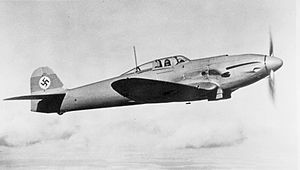Heinkel He 112
| He 112 | |
|---|---|
 |
|
| He 112 in flight | |
| Role | Fighter |
| Manufacturer | Heinkel |
| Designer | Günter brothers |
| First flight | September 1935 |
| Primary users |
Luftwaffe Spanish Air Force Royal Hungarian Air Force Royal Romanian Air Force |
| Number built | 104 |
| Developed from | Heinkel He 70 |
The Heinkel He 112 is a German fighter aircraft designed by Walter and Siegfried Günter. It was one of four aircraft designed to compete for the Luftwaffe's 1933 fighter contract, which was eventually won by the Messerschmitt Bf 109, although it was second place in the contest. Small numbers were used for a short time by the Luftwaffe, and small runs were completed for several other countries, but only around 100 were completed in total.
In the early 1930s, the German authorities started placing orders for new aircraft, initially training and utility aircraft. Heinkel, as one of the most experienced firms in the country, received contracts for a number of two-seat aircraft, including the He 45, He 46 and He 50. The company also worked on single-seat fighter designs, which culminated in the He 49 and later with the improved He 51.
When the He 51 was tested in combat in the Spanish Civil War, it was shown that speed was far more important than maneuverability. The Luftwaffe took this lesson to heart, and started a series of design projects for much more modern aircraft. One of these projects, Rüstungsflugzeug IV, called for a day fighter with a top speed of 400 km/h (250 mph) at 6,000 m (19,500 ft) which it could maintain for 20 minutes out of a total endurance of 90 minutes. It also needed to be armed with at least three machine guns with 1,000 rpg, or one 20 mm cannon with 200 rounds. The specification required that the wing loading should be below 100 kg/m² - a way of defining the aircraft's ability to turn and climb. The priorities for the aircraft were level speed, climb speed, and then maneuverability in that order.
In October 1933, Hermann Göring sent out a letter requesting aircraft companies consider the design of a "high speed courier aircraft" - a thinly veiled request for a new fighter. In May 1934, this was made official and the Technisches Amt sent out a request for a single-seat interceptor for the Rüstungsflugzeug IV role, this time under the guise of a "sports aircraft". The specification was first sent to the most experienced fighter designers, Heinkel, Arado, and Focke-Wulf. It was later sent to newcomer Bayerische Flugzeugwerke (Bavarian Aircraft Works or BFW) on the strength of their Bf 108 Taifun advanced sportsplane design. Each company was asked to build three prototypes for run-off testing. By spring 1935, both the Arado and Focke-Wulf aircraft were ready, the BFW arriving in March, and the He 112 in April.
...
Wikipedia
